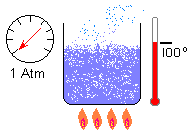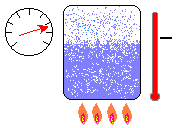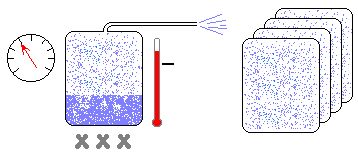
|
An ordinary cup of coffee may be hot and on a cold day you
might see a wisp of steam rising from it but hardly enough
to run an engine. To understand better we'll have to look
inside...
|

|
What we see is water sitting in the cup.
What did you expect it to do? Even if we look closely
the only thing there is hot liquid. To get bubbles and then
steam we have to heat it up...
|

|
Now the water is boiling. The liquid is turning into gas.
Mostly this is happening under the surface and the gas (that
is the steam) rises to the surface and escapes to the
atmosphere. Note the following:
- The pressure is just 'one atmosphere' ie room pressure
- No matter how hot you make the flames underneath the
water never gets hotter than 100 degrees
- If you take the heat away it stops boiling
To turn a kettle into a boiler we need to seal in
the water...
|

|
When water is boiled in a closed container
the steam being boiled-off from the
water has nowhere to go. It builds up inside the container and
causes the pressure to rise. (If the container is not strong
enough it will more than likely kill somebody as it
explodes.) As the pressure rises so the temperature needed
to make more steam increases. If some of the heat can't be
used to make steam then it has to go into heating up the liquid.
The result is:-
- High pressure steam
- High temperature steam
- Liquid just waiting for a drop in pressure to flash into
steam.
We now have just the sort of steam engines like. But
the third item is what makes a boiler different to other
pressure vessels...
|

|
If you take away the heat from a boiler it doesn't get any
hotter and the pressure won't increase. It just sits there with
say a quarter of the volume being steam and three quarters water
above boiling point.
But look what happens if we start to take some of the steam out
of the boiler. As soon as we remove a bit of steam, the
pressure drops slightly. The superheated water now boils a
little bit - replacing the steam just removed. This is
the secret of boilers. We can keep removing steam - lots of it
- many times the volume of the boiler in one go.
|
Of course you normally keep a boiler fired-up while you're using it, but the
wonderful property of being able to generate so much steam in a short period
without extra heat means that a small but steady heat is able to drive something
very powerfull for a short time. When the demand for steam is less the
boiler is storing energy for future use.




